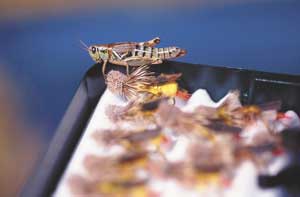
As the weather heats up, the fly fisher should begin thinking about fishing terrestrials for trout.
Terrestrials are non-aquatic insects such as ants, grasshoppers, beetles and inchworms.
These insects have no aquatic life stage, unlike Mayflies, caddises, stoneflies or midges. They also make approximately 80 percent of a trout’s diet during the summer months and are essential fly patterns to carry during this time.
Trout don’t care if their food hatches in the stream or falls from above into their streams. Hatches of aquatic insects begin to wane during the warmer summer months, and trout then will begin to key on terrestrials.
Anglers at this time shouldn’t neglect flies that imitate these creatures.
Size is important when fishing terrestrials.
If the size of the grasshoppers along the bank of the stream an angler is fishing are Size 14 and the angler’s fishing a Size-8 hopper pattern, the trout likely won’t take those flies.
Always carry a wide variety of terrestrials in different sizes to match any insect and size that you might observe in the stream habitat.
Grasshopper (hopper) patterns should be fished near grassy banks, as close to the banks as possible.
Windy days are ideal, as the hoppers get blown into the water and trout will be on the lookout for them.
Cast to a likely spot and let the hopper dead-drift for a few seconds before giving it some movement. A grasshopper will try to swim by kicking its rear legs in unison. This action can be mimicked by using short, abrupt twitches of the fly line.
After several of these maneuvers, let the hopper fly rest before resuming twitches.
Casting a hopper with a hard landing on the water will get a trout’s attention, often drawing an immediate, vicious strike. At other times, casting a hopper fly onto the far bank and dropping it softly into the water is the most natural and effective presentation.
Almost all hopper patterns are fished as dry flies.
Some proven hopper dry fly patterns are Joe’s Hopper, Dave’s Hopper, Letort Hopper, and the Meadow Hopper.
Cricket patterns can be fished the same way as hoppers.
During the summer months, ants probably make up the largest part of a trout’s diet in southern freestone streams. Ants are prevalent throughout most of the year and trout love them.
If an angler finds an area with lots of ants at stream banks, find a pattern with the appropriate color and size and fish it tightly near the bank.
Ants are easily plucked from the stream banks and overhanging tree limbs by wind and drops of rain. Windy days and hours immediately after a rain will be the best times to fish ant patterns.
Ants can be fished as dry fly or subsurface patterns.
Ants fished as dry flies can be difficult to see on the water, because of their color and size. Flies tied in the parachute style can make them much easier to see when on the water.
Dead-drifting a fly with little or no movement is the best presentation.
Ant patterns fished below the surface, such as a drowned ant, can be fished with a strike indicator or as a dropper tied from another larger, more buoyant dry fly.
The simple black and cinnamon ant patterns in a variety of sizes will be effective, as well as the Chernobyl Ant fly pattern. The Chernobyl Ant floats well and is much easier to see.
Areas of at stream with low-hanging, leafy tree limbs are terrestrial-producing machines. Flies that imitate beetles, inchworms, and ants will easily take trout at such places.
Keeping the fly line low to the water with a sidearm cast will place a fly underneath limbs and branches, which is where the trout will be holding most of the time.
Summer means the end of most aquatic insect hatches at southern freestone streams. But that’s not a good reason to put away one’s fly rod and waders.
Take some terrestrial patterns to your favorite trout stream and enjoy some of the most productive and exciting fishing of the year.



Be the first to comment